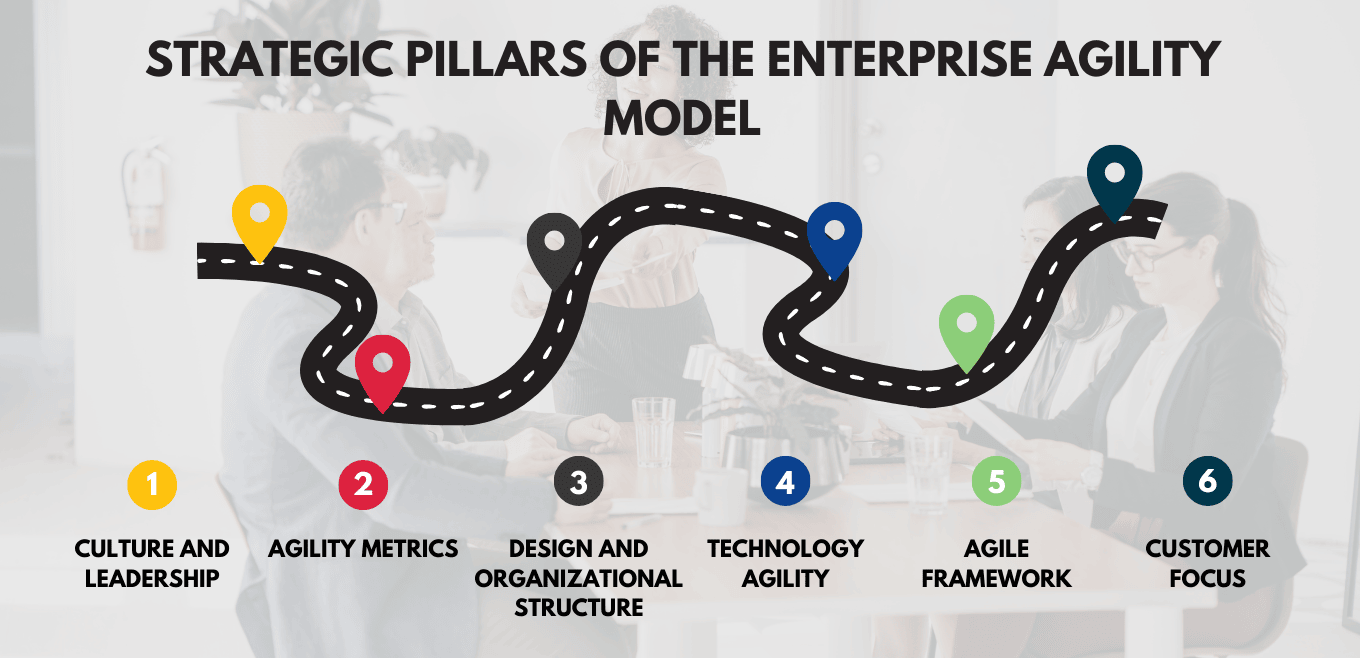In today’s era of constant business disruption, one certainty is that change is inevitable. To navigate these shifts whether driven by the impacts of a pandemic, evolving expectations around remote and hybrid work, or increasing demands for sustainability and operational transparency organizations must develop enterprise agility.
Enterprise agility is adapting swiftly, learning from challenges, and delivering results efficiently. Achieving this level of flexibility requires focusing on key strategic pillars, including innovation, customer-centricity, leadership, and organizational culture.
In this blog, we will explore how to cultivate enterprise agility and examine effective strategies and patterns that organizations can adopt to thrive in a rapidly changing business environment.
What is enterprise agility?
Enterprise agility refers to a large organization’s ability to swiftly and effectively adapt to changes in the business environment. It involves adopting agile principles and practices at the corporate level, enabling the organization to respond quickly to market trends, customer demands, and competitive pressures.
Achieving enterprise agility requires breaking down organizational silos, fostering collaboration, encouraging innovation, and implementing flexible, adaptive processes. The goal is to create a more resilient and responsive organization that can seize opportunities, navigate uncertainty, and consistently deliver value to customers in an ever-evolving business landscape.
Fundamentals of enterprise agility

Enterprise agility is about cultivating a resilient, flexible, and adaptive organization that can thrive in dynamic environments. To achieve true agility, organizations must embrace the following key principles:
- Predicting customer needs: Being proactive rather than reactive is the essence of enterprise agility. By anticipating customer needs, you can stay ahead of the competition and deliver products and services that meet those needs before customers are even aware of them. This forward-thinking approach not only drives innovation but also enhances customer satisfaction, positioning your organization as a market leader.
- Disrupting before being disrupted: The core of enterprise services lies in being flexible and bold enough to challenge your business model before external forces do. This means having the courage to innovate, experiment, and take risks, even when venturing into uncharted territory. By proactively disrupting your operations, you stay ahead of the competition, ensuring long-term resilience and growth.
- Continuous improvement: At the heart of enterprise agility is the commitment to being a learning organization that prioritizes continuous improvement. This means fostering a culture where innovation is encouraged, mistakes are seen as learning opportunities, and successes are built upon. By constantly evolving, your organization can remain competitive and drive sustained growth.
- Delivering quickly: A key element of enterprise agility is providing services to software product development rapidly without sacrificing quality. This requires fostering a culture that values speed and efficiency, supported by streamlined processes and optimized workflows. By achieving fast, reliable delivery, organizations can better meet customer demands and stay ahead in competitive markets.
- Thrive in a competitive market: Enterprise agility is fundamentally about excelling in dynamic, competitive environments. It requires the flexibility to pivot quickly, adapt to evolving market conditions, and consistently stay ahead of competitors. By being agile, organizations can not only survive but thrive, maintaining a competitive edge and seizing new opportunities.
Strategic pillars of the enterprise agility model
Enterprise agility is a strategic framework that enables organizations to become more adaptive and responsive. It is built on seven strategic pillars that empower an organization to learn and pivot, deliver rapidly, adapt to change, and succeed in a highly competitive market. These pillars form the foundation for driving continuous improvement and long-term growth while fostering resilience in disruption.


1. Culture and leadership
- Establish a clear mission and vision for the company.
- Make sure the leadership is dedicated to creating an agile culture.
- Create a governance framework that facilitates swift and effective decision-making.
- Cultivate a culture that promotes continuous learning and adaptability across the levels of the organization.
2. Agility metrics
- Enterprise agility places a strong emphasis on quantifying the value that the company provides.
- One of the most important components of enterprise agility is guaranteeing the quality of goods and services.
- Flow metrics in enterprise agility relate to the efficiency of work processes.
3. Design and organizational structure
- To improve cooperation, form cross-functional teams.
- Put into practice agile organizational structures like chapters, tribes, and squads.
- Encourage an open and communicative culture.
- Implement enterprise collaboration tools to enhance departmental coordination and communication.
4. Technology agility
- Invest in technology that encourages creativity and adaptability.
- Use automation tools to make procedures more efficient.
- Make sure your IT infrastructure can grow and change to meet your evolving needs.
5. Agile framework
- Adopt and modify agile approaches (like Kanban) to meet the requirements of your company.
- Teams implementing agile practices should receive assistance and training.
- Promote the application of agile frameworks in agile product development and project management.
6. Customer focus
- Give customers’ opinions top priority and include them in the development process.
- Use customer-focused techniques like design thinking.
- Quickly adapt to shifting consumer demands and market conditions.
Implementing enterprise agility: A step-by-step approach with strategic insights
Fostering enterprise agility is not a one-time task but an ongoing process that requires structural, cultural, and procedural changes across the entire organization. Large enterprises, due to their size and complexity, often face unique challenges when trying to implement agile practices. Below is a step-by-step approach that combines practical steps with strategic insights to guide your enterprise toward enhanced agility.
1. Establish a vision for agility
The journey toward enterprise agility begins with a clear vision. This vision should reflect not just operational changes but a cultural transformation.
- Define and communicate the agility vision across all levels of the organization.
- Leadership buy-in is critical—ensure the executive team is fully committed to fostering an agile culture and willing to champion it across the enterprise.
- Align the vision with the company’s long-term goals, ensuring agility contributes to both customer satisfaction and business growth.
2. Conduct an agility assessment
Before diving into implementation, assess the current state of agility in your enterprise.
- Identify gaps in your processes, structures, and culture that hinder agility. Use this assessment to understand your strengths and weaknesses.
- Map out opportunities where agility can drive improvements—whether in product development, service delivery, or customer engagement.
This assessment will provide a foundation for creating a tailored roadmap for your agile transformation.
3. Build agile leadership
Agile transformations start at the top. Building a leadership team that embodies agile principles is essential for fostering agility enterprise-wide.
- Leadership training should focus on agile principles, change management, and empowering teams to be self-organized.
- Encourage leaders to model agile behaviors, like adaptability, quick decision-making, and promoting continuous learning.
- Leaders should champion cross-functional collaboration and help break down silos across departments to ensure agility thrives.
4. Cultivate a culture of agility
Agility is not just about adopting new processes; it’s about fostering a culture that thrives on adaptability, learning, and innovation.
- Encourage experimentation: Create a safe environment where teams feel empowered to take calculated risks, learn from failures, and iterate quickly.
- Promote a growth mindset by embedding continuous learning into the company’s DNA. Regular training sessions, workshops, and knowledge-sharing platforms will help keep your teams agile and forward-thinking.
- Cross-functional teams are crucial in this culture—encourage collaboration across departments to generate fresh ideas and accelerate decision-making.
5. Form a cross-functional transformation team
Large enterprises can struggle with agility due to siloed teams. Forming a cross-functional transformation team can break down barriers.
- This team, comprised of members from different business units, will lead the implementation of agile practices and ensure that all departments are aligned with the agility vision.
- The dedicated software teams should act as change agents, fostering collaboration and addressing challenges that arise as the organization transitions to a more agile way of working.
6. Implement agile methodologies
Choosing and implementing agile methodologies that fit the needs of your enterprise is critical.
- Scrum, Kanban, or hybrid approaches can be piloted within departments that are ready for change, and once proven successful, these can be scaled to other parts of the organization.
- Ensure that the teams are properly trained and supported in using these frameworks, so they can embrace the flexibility, transparency, and speed that agile methodologies bring.
- As your organization scales agility, regularly review and adapt the chosen methodologies to ensure they remain relevant to your evolving business needs.
7. Invest in technology to enhance agility
Large enterprises need scalable technology that supports agility. Modern tech infrastructure plays a vital role in enabling agile practices.
- Automation tools, cloud-based platforms, and enterprise software development can streamline workflows, enhance communication, and allow teams to respond faster to changing market demands.
- Ensure your IT infrastructure is flexible and scalable, able to evolve as your organization’s needs grow. This will enable you to pivot quickly when necessary and deliver customer value without delays.
8. Focus on continuous learning and innovation
An agile enterprise services provider never stops learning. To maintain long-term agility, invest in continuous learning and ensure innovation stays at the heart of your operations.
- Regular training on agile practices, leadership development programs, and cross-departmental knowledge sharing will keep teams updated with the latest industry trends.
- Iterative approaches allow the organization to continuously improve and pivot based on feedback from the market and internal insights.
9. Measure agility through metrics
For large enterprises to effectively gauge the success of their agility efforts, it is essential to establish a system that measures key outcomes.
- Implement agility metrics that assess flow efficiency, speed of delivery, and customer satisfaction. These metrics will help identify bottlenecks in the process and ensure that agility is driving business results.
- Regular reviews of these metrics allow for strategic adjustments, ensuring your organization remains competitive and responsive to evolving customer demands.
Conclusion: Achieve enterprise agility with People10
In today’s rapidly evolving business environment, agility is crucial for large enterprises to remain competitive. At People10, we recognize the challenges of transitioning to an agile organization and are dedicated to guiding your transformation. Our team of experts specializes in helping organizations adopt and scale agile practices that drive innovation, optimize operations, and deliver sustained value.
By partnering with an agile software development company- People10, you leverage industry leading expertise and customized solutions designed to meet your specific needs, ensuring your enterprise can swiftly respond to market changes and maintain a competitive edge.
Author
A seasoned tech leader with 20+ years of experience, Nisha drives global business development and client relations at People10.



